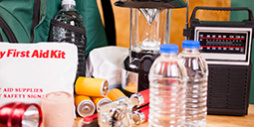
If disaster strikes, you may only have a few minutes to gather your loved ones and important items before leaving your home. Packing an emergency kit that you can easily grab if you have to evacuate is essential.
Make sure everyone knows where the emergency kit is stored and check it twice a year to replace out-of-date items. It’s also a good idea to keep an emergency kit in the car and have a back-up stashed in a different part of the house.
When preparing a home kit, include the following:
- Three-day supply of nonperishable food for each family member
- Three-day supply of water for each person – one gallon per person, per day
- Multipurpose tool or can opener
- Flashlight
- Hand-crank or battery-powered radio that can tune into National Oceanic and Atmospheric Administration weather updates; see a list of stations in your area here
- Extra batteries
- Cell phone with chargers (consider a solar charger and car charger)
- First-aid kit
- Prescription medications
- Extra cash
- Local maps
- Wrench or pliers to turn off utilities
- Whistle
- Dust masks, plastic sheeting and duct tape
- Moist towelettes
- Garbage bags and plastic ties
- Travel-size personal hygiene products, including toothbrush, toothpaste and hand sanitizer
- Clothing and bedding, including sleeping bags and pillows
- Hard copies or electronic records of important documents, such as birth certificates, social security cards, driver’s licenses, passports, insurance cards and medical documents
- Pet food and other items for your pets, such as litter boxes and leashes
Additional items to include in your car emergency kit:
- Comfortable shoes
- Backpack
- Flares
- Jumper cables
- Basic toolkit
Consider keeping a two-week supply of non-perishable food and water at home in case you’re stuck without power for an extended period of time.
Make sure you’re covered if disaster strikes. For information about auto and home insurance, call your AAA insurance agent or insurance customer service, or visit your local branch.
Learn more about AAA Insurance agency


